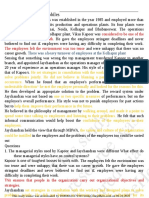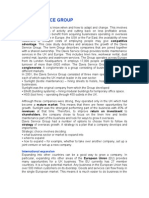0%(1)0% found this document useful (1 vote)
1K viewsCorporate and Division Strategic Planning
Corporate and Division Strategic Planning
Uploaded by
Sean Chris ConsonCorporations take different approaches to strategic planning: some give business units freedom over goals and strategies, others set goals but allow flexibility in strategies, and some control both goals and strategies. Successful strategic planning requires managing a company's business portfolio, assessing market opportunities, and establishing strategies. Companies undertake strategic planning at multiple levels from corporate headquarters down to individual products. Corporate headquarters defines the company mission, establishes strategic business units, assigns resources to those units, and assesses growth opportunities.
Copyright:
© All Rights Reserved
Available Formats
Download as DOCX, PDF, TXT or read online from Scribd
Corporate and Division Strategic Planning
Corporate and Division Strategic Planning
Uploaded by
Sean Chris Conson0%(1)0% found this document useful (1 vote)
1K views2 pagesCorporations take different approaches to strategic planning: some give business units freedom over goals and strategies, others set goals but allow flexibility in strategies, and some control both goals and strategies. Successful strategic planning requires managing a company's business portfolio, assessing market opportunities, and establishing strategies. Companies undertake strategic planning at multiple levels from corporate headquarters down to individual products. Corporate headquarters defines the company mission, establishes strategic business units, assigns resources to those units, and assesses growth opportunities.
Original Description:
c
Copyright
© © All Rights Reserved
Available Formats
DOCX, PDF, TXT or read online from Scribd
Share this document
Did you find this document useful?
Is this content inappropriate?
Corporations take different approaches to strategic planning: some give business units freedom over goals and strategies, others set goals but allow flexibility in strategies, and some control both goals and strategies. Successful strategic planning requires managing a company's business portfolio, assessing market opportunities, and establishing strategies. Companies undertake strategic planning at multiple levels from corporate headquarters down to individual products. Corporate headquarters defines the company mission, establishes strategic business units, assigns resources to those units, and assesses growth opportunities.
Copyright:
© All Rights Reserved
Available Formats
Download as DOCX, PDF, TXT or read online from Scribd
Download as docx, pdf, or txt
0%(1)0% found this document useful (1 vote)
1K views2 pagesCorporate and Division Strategic Planning
Corporate and Division Strategic Planning
Uploaded by
Sean Chris ConsonCorporations take different approaches to strategic planning: some give business units freedom over goals and strategies, others set goals but allow flexibility in strategies, and some control both goals and strategies. Successful strategic planning requires managing a company's business portfolio, assessing market opportunities, and establishing strategies. Companies undertake strategic planning at multiple levels from corporate headquarters down to individual products. Corporate headquarters defines the company mission, establishes strategic business units, assigns resources to those units, and assesses growth opportunities.
Copyright:
© All Rights Reserved
Available Formats
Download as DOCX, PDF, TXT or read online from Scribd
Download as docx, pdf, or txt
You are on page 1of 2
b.
Corporate and Division Strategic Planning
Some corporations give their business units freedom to set their own sales and profit goals
and strategies. Others set goals for their business units but let them develop their own strategies.
Still others set the goals and participate in developing individual business unit strategies.
The Central Role of Strategic Planning
Successful marketing thus requires capabilities such as understanding, creating, delivering,
capturing, and sustaining customer value.
To ensure they select and execute the right activities, marketers must give priority to
strategic planning in three key areas:
1. managing a company’s businesses as an investment portfolio,
2. assessing each business’s strength by considering the market’s growth rate and the
company’s position and fit in that market
3. establishing a strategy.
The company must develop a game plan for achieving each business’s long-run objectives.
Most large companies consist of four organizational levels: (1) corporate, (2) division, (3)
business unit, and (4) product.
o Corporate headquarters is responsible for designing a corporate strategic plan to
guide the whole enterprise; it makes decisions on the amount of resources to
allocate to each division, as well as on which businesses to start or eliminate. Each
division establishes a plan covering the allocation of funds to each business unit
within the division.
o Each business unit develops a strategic plan to carry that business unit into a
profitable future.
o Finally, each product level (product line, brand) develops a marketing plan for
achieving its objectives.
The marketing plan is the central instrument for directing and coordinating the marketing
effort. It operates at two levels: strategic and tactical.
o The strategic marketing plan lays out the target markets and the firm’s value
proposition, based on an analysis of the best market opportunities.
o The tactical marketing plan specifies the marketing tactics, including product
features, promotion, merchandising, pricing, sales channels, and service. The
complete planning, implementation, and control cycle of strategic planning
All corporate headquarters undertake four planning activities:
1. Defining the corporate mission
Organizations develop mission statements to share with managers, employees, and
customers. A clear, thoughtful mission statement provides a shared sense of purpose,
direction, and opportunity. Mission statements are at their best when they reflect a vision,
an almost “impossible dream” that provides direction for the next 10 to 20 years.
Good mission statements have five major characteristics.
o They focus on a limited number of goals.
o They stress the company’s major policies and values.
o They define the major competitive spheres within which the company will operate.
o They take a long-term view.
o They are as short, memorable, and meaningful as possible
2. Establishing strategic business units
A target market definition tends to focus on selling a product or service to a current market.
A strategic market definition also focuses on the potential market. A business can define
itself in terms of three dimensions: customer groups, customer needs, and technology.
Large companies normally manage quite different businesses, each requiring its own
strategy.
Businesses were classified into strategic business units (SBUs). An SBU has three
characteristics:
It is a single business, or a collection of related businesses, that can be planned
separately from the rest of the company.
It has its own set of competitors.
It has a manager responsible for strategic planning and profit performance, who
controls most of the factors affecting profit.
The purpose of identifying the company’s strategic business units is to develop separate
strategies and assign appropriate funding. Senior management knows its portfolio of
businesses usually includes a number of “yesterday’s has-beens” as well as “tomorrow’s
breadwinners.”
3. Assigning resources to each strategic business unit
Once it has defined SBUs, management must decide how to allocate corporate resources to
each. Several portfolio-planning models provide ways to make investment decisions.
Portfolio-planning models like these have fallen out of favor as oversimplified and
subjective. Newer methods rely on shareholder value analysis, and on whether the market
value of a company is greater with an SBU or without it.
4. Assessing growth opportunities
Assessing growth opportunities includes planning new businesses, downsizing, and
terminating older businesses. If there is a gap between future desired sales and projected
sales, corporate management will need to develop or acquire new businesses to fill it.
The first option is to identify opportunities for growth within current businesses (intensive
opportunities). The second is to identify opportunities to build or acquire businesses related
to current businesses (integrative opportunities). The third is to identify opportunities to
add attractive unrelated businesses (diversification opportunities).
You might also like
- Shaping The Market OfferingsDocument37 pagesShaping The Market OfferingsSuvendu Pratihari100% (3)
- 1b Wheelen Hunger Strategic Management ModelDocument3 pages1b Wheelen Hunger Strategic Management ModelMuhd Farid83% (6)
- Short Note - Economics - JAIBBDocument28 pagesShort Note - Economics - JAIBBMuhammad Akmal Hossain100% (6)
- Grand Strategy MatrixDocument8 pagesGrand Strategy MatrixKyung SooNo ratings yet
- This Study Resource Was Shared Via: CW Study Victor AutomobilesDocument2 pagesThis Study Resource Was Shared Via: CW Study Victor Automobilessatrioda100% (1)
- Cafe Coffee DayDocument2 pagesCafe Coffee DayMerwyn FernandesNo ratings yet
- Term Paper of Supply Chain ManagementDocument11 pagesTerm Paper of Supply Chain ManagementShuvro Ahsan67% (3)
- What Is Strategic AnalysisDocument4 pagesWhat Is Strategic AnalysisKeith Joshua Gabiason100% (1)
- Strategy Implementation PowerpointDocument14 pagesStrategy Implementation PowerpointThine RoseteNo ratings yet
- Features of Business PolicyDocument2 pagesFeatures of Business PolicyjessaNo ratings yet
- Business Policy 3Document20 pagesBusiness Policy 3Manish Singh100% (1)
- Total Rewards ModelDocument5 pagesTotal Rewards ModelHeru Wiryanto100% (1)
- MKT Marketing ch-2Document21 pagesMKT Marketing ch-2Sharif HossinNo ratings yet
- 0.2corporate and Division Strategic Planning Business Unit Strategic PlanningDocument7 pages0.2corporate and Division Strategic Planning Business Unit Strategic PlanningAnonymous 3At7NSNo ratings yet
- PART 5 - Shaping The Market Offerings PDFDocument91 pagesPART 5 - Shaping The Market Offerings PDFhieu2100No ratings yet
- TOWS and BCG MatrixDocument27 pagesTOWS and BCG MatrixSwati JainNo ratings yet
- Managing Brands Over Geographic Boundaries and Market SegmentsDocument15 pagesManaging Brands Over Geographic Boundaries and Market SegmentsMaulana AdzkiyaNo ratings yet
- Ansoff MatrixDocument8 pagesAnsoff MatrixChitranjan SharmaNo ratings yet
- Business Planning ProcessDocument53 pagesBusiness Planning ProcessGangadhar100% (2)
- Buying MotiveDocument10 pagesBuying MotiveAbhishek kumarNo ratings yet
- BPSM Notes of Unit 1Document6 pagesBPSM Notes of Unit 1Arpita DevNo ratings yet
- Unit IV Part 1 Notes BP&SDocument18 pagesUnit IV Part 1 Notes BP&SJunaid Siddiqui100% (1)
- Relation Between Roi and Eva-1Document11 pagesRelation Between Roi and Eva-1Jasleen KaurNo ratings yet
- Corporate Directional Strategies: Prentice Hall, 2004 Wheelen/Hunger 1Document31 pagesCorporate Directional Strategies: Prentice Hall, 2004 Wheelen/Hunger 1Yuki Dwi DarmaNo ratings yet
- Environmental Forecasting: Meaning and Techniques Deepali Hiremath Assistant ProfessorDocument21 pagesEnvironmental Forecasting: Meaning and Techniques Deepali Hiremath Assistant ProfessorJessuel Larn-epsNo ratings yet
- Strategic Management Full NotesDocument133 pagesStrategic Management Full Notessahir_sameer1984100% (1)
- Chapter 8 - Evaluating Supervising and Controlling Sales and SalesDocument26 pagesChapter 8 - Evaluating Supervising and Controlling Sales and SalesSubashNo ratings yet
- What Is Productivity?Document52 pagesWhat Is Productivity?satishNo ratings yet
- Strategy Review, Evaluation and ControlDocument27 pagesStrategy Review, Evaluation and Controldonna mendoza100% (1)
- Chap019.Third-Party Approaches To Managing Difficult NegotiationsDocument34 pagesChap019.Third-Party Approaches To Managing Difficult NegotiationsAkash RanjanNo ratings yet
- S3 Corporate Level StrategiesDocument15 pagesS3 Corporate Level Strategiespravit08No ratings yet
- Marketing ManagementDocument3 pagesMarketing ManagementAnandRajNo ratings yet
- Chapter 4-Building Competitive Advantage Through Functional Level StrategyDocument25 pagesChapter 4-Building Competitive Advantage Through Functional Level Strategymjr0% (1)
- Guide For Case AnalysisDocument26 pagesGuide For Case AnalysisSubhankar Bera100% (1)
- 4 - Planning and Strategic ManagementDocument35 pages4 - Planning and Strategic ManagementEmmanuel DaguroNo ratings yet
- Question Paper Unsolved - Indian Management Thoughts & PracticesDocument11 pagesQuestion Paper Unsolved - Indian Management Thoughts & PracticesAbhijeet Kulshreshtha100% (6)
- HR Planning - ppt-1Document38 pagesHR Planning - ppt-1AbinashMahapatra100% (1)
- Strategic Management Unit-I Strategy and Process 9: Corpo Rate Strate GY Business StrategyDocument90 pagesStrategic Management Unit-I Strategy and Process 9: Corpo Rate Strate GY Business StrategySujata SuryawanshiNo ratings yet
- BPSM NotesDocument15 pagesBPSM Notesdeepikab_21No ratings yet
- Difference Between Production and Operations ManagementDocument2 pagesDifference Between Production and Operations Managementarpit verma100% (1)
- Holistic MarketingDocument82 pagesHolistic MarketingVikas MarkanNo ratings yet
- Concept of Responsibility CentreDocument5 pagesConcept of Responsibility Centrevijayadarshini vNo ratings yet
- Nature and Scope of Managerial EconomicsDocument37 pagesNature and Scope of Managerial EconomicsYandex PrithuNo ratings yet
- Performance PyramidDocument15 pagesPerformance PyramidAsma AliNo ratings yet
- 6 Gathering Performance InformationDocument39 pages6 Gathering Performance InformationDewesh Shukla0% (2)
- Davis Case StudyDocument4 pagesDavis Case StudyMuhammad Abid100% (1)
- Merchandise Budget PlanDocument5 pagesMerchandise Budget Planyasir khanNo ratings yet
- Describe The Benefits of Having A Clear Mission and Vision StatementDocument2 pagesDescribe The Benefits of Having A Clear Mission and Vision StatementAlemayehu DemekeNo ratings yet
- Sales Control and Cost AnalysisDocument8 pagesSales Control and Cost Analysisimad50% (2)
- Sustainable Business Survey QuestionnaireDocument9 pagesSustainable Business Survey Questionnairedeniseflim100% (1)
- IBM - Unit - IIIDocument30 pagesIBM - Unit - IIIYuvaraj d67% (3)
- Unit 1: Overview of Ethical Choices in HRM and Expected Professional Standards (Online Lecture - Week 2)Document26 pagesUnit 1: Overview of Ethical Choices in HRM and Expected Professional Standards (Online Lecture - Week 2)AISHWARYA SHENOY K P 2127635No ratings yet
- Scope of Marketing ResearchDocument10 pagesScope of Marketing ResearchLakshmipathy KsNo ratings yet
- NepalDocument22 pagesNepalpsdakopindo100% (1)
- CHAPTER-1 Nature-of-StatMgmt STRAT MGMTDocument11 pagesCHAPTER-1 Nature-of-StatMgmt STRAT MGMTAmara BlessNo ratings yet
- Competition Act 2002Document19 pagesCompetition Act 2002Vatsal ChauhanNo ratings yet
- Strategic Business Unit and Functional Level StrategiesDocument12 pagesStrategic Business Unit and Functional Level StrategiesMhyr Pielago CambaNo ratings yet
- Plant Layout Operation ManagementDocument7 pagesPlant Layout Operation ManagementKAPIL VARSHNEYNo ratings yet
- Group DynamicsDocument27 pagesGroup DynamicsJoyce Angelica MendigorinNo ratings yet
- Chapter Two: Winning Markets Through Strategic Planning, Implementation, and ControlDocument58 pagesChapter Two: Winning Markets Through Strategic Planning, Implementation, and ControlAbdifatah AhmedNo ratings yet
- Kotler Pom16e Inppt 02Document47 pagesKotler Pom16e Inppt 02Nashran Harith Nazree100% (1)
- Marketing StrategyDocument55 pagesMarketing Strategydhamijaarmaan86No ratings yet
- Updating The 4 P'S: The 7 P's of Marketing MixDocument3 pagesUpdating The 4 P'S: The 7 P's of Marketing MixSean Chris ConsonNo ratings yet
- Who Markets? Marketers and Prospects.: Full Demand-Consumers Are Adequately Buying All Products Put Into The MarketplaceDocument2 pagesWho Markets? Marketers and Prospects.: Full Demand-Consumers Are Adequately Buying All Products Put Into The MarketplaceSean Chris Conson0% (1)
- C. The New Marketing RealitiesDocument2 pagesC. The New Marketing RealitiesSean Chris ConsonNo ratings yet
- D. Company Orientation Toward The MarketplaceDocument2 pagesD. Company Orientation Toward The MarketplaceSean Chris ConsonNo ratings yet
- Discuss The Following Based On Your Observation On The PracticesDocument2 pagesDiscuss The Following Based On Your Observation On The PracticesSean Chris ConsonNo ratings yet
- Was Sony Corporation Ever Engaged in Unfair CompetitionDocument1 pageWas Sony Corporation Ever Engaged in Unfair CompetitionSean Chris ConsonNo ratings yet
- The Scope of Antitrust LawsDocument1 pageThe Scope of Antitrust LawsSean Chris ConsonNo ratings yet
- Statistical Treatment of The DataDocument1 pageStatistical Treatment of The DataSean Chris ConsonNo ratings yet
- What Is The ShermanDocument1 pageWhat Is The ShermanSean Chris ConsonNo ratings yet
- Pareto Principle and Its ExamplesDocument1 pagePareto Principle and Its ExamplesSean Chris ConsonNo ratings yet
- Explain The Importance of ValueDocument1 pageExplain The Importance of ValueSean Chris ConsonNo ratings yet
- Pareto Principle and Its ExamplesDocument1 pagePareto Principle and Its ExamplesSean Chris ConsonNo ratings yet
- Pareto Principle and Its ExamplesDocument1 pagePareto Principle and Its ExamplesSean Chris ConsonNo ratings yet
- Tips in Designing RubricsDocument2 pagesTips in Designing RubricsJay-ar JaneoNo ratings yet
- The Sun Rising Poem AnalysisDocument7 pagesThe Sun Rising Poem AnalysisTM100% (1)
- Craig Bourne - A Future For Presentism - Oxford University Press, USA (2009)Document257 pagesCraig Bourne - A Future For Presentism - Oxford University Press, USA (2009)luistbf100% (1)
- Peace Education Group 1Document4 pagesPeace Education Group 1marissalibosana9No ratings yet
- Housemates American English StudentDocument7 pagesHousemates American English StudentMónica Peralta TorresNo ratings yet
- Fugacity and Equilibrium Calculations PDFDocument13 pagesFugacity and Equilibrium Calculations PDFRbtl BañosNo ratings yet
- CHP 2 Market Forces Demand and Supply. Part I - CANVASDocument20 pagesCHP 2 Market Forces Demand and Supply. Part I - CANVAShimanshu varandaniNo ratings yet
- Genres of MusicDocument43 pagesGenres of Musicmatthewmoss28No ratings yet
- Traditional GamesDocument2 pagesTraditional GamesNiel S. DefensorNo ratings yet
- View PDFDocument7 pagesView PDFJuman Jay CalumpagNo ratings yet
- Soal Bahasa Inggriskelas Xi Lintas Minat Ujian Semester Ganjil 2019Document12 pagesSoal Bahasa Inggriskelas Xi Lintas Minat Ujian Semester Ganjil 2019Desi SuryaniNo ratings yet
- Test Your English Tests - 9328Document9 pagesTest Your English Tests - 9328Tanya Florea100% (1)
- LEXICOLOGY Seminar 3Document6 pagesLEXICOLOGY Seminar 3Ivanka PereymaNo ratings yet
- Welcome-to-Our-SchoolDocument8 pagesWelcome-to-Our-SchoolsharifxonelbekNo ratings yet
- Lomboy Blotter EntryDocument2 pagesLomboy Blotter EntryMayck Jhoenell LomboyNo ratings yet
- A Fistful of DiceDocument44 pagesA Fistful of DiceSam Beuglass100% (1)
- Middle Test English Lesson Keperawatan Semester 4Document14 pagesMiddle Test English Lesson Keperawatan Semester 4Syafara Al QomariyahNo ratings yet
- Analysis of A Tunnel For Rishikesh-Karanprayag Railway Line ProjectDocument54 pagesAnalysis of A Tunnel For Rishikesh-Karanprayag Railway Line ProjectVartika DixitNo ratings yet
- Tugas 5Document17 pagesTugas 5Syafiq RamadhanNo ratings yet
- Pre Paid Metering SystemDocument104 pagesPre Paid Metering Systemmv_mallik100% (1)
- Precarious Communism: Manifest Mutations, Manifesto DetournedDocument151 pagesPrecarious Communism: Manifest Mutations, Manifesto DetournedMinor Compositions100% (3)
- Belykh, E., Krutko, A. V., Baykov, E. S., Giers, M. B., Preul, M. C., & Byvaltsev, V. A. (2017). Preoperative estimation of disc herniation recurrence after microdiscectomy predictive value of a multivariate model basedDocument11 pagesBelykh, E., Krutko, A. V., Baykov, E. S., Giers, M. B., Preul, M. C., & Byvaltsev, V. A. (2017). Preoperative estimation of disc herniation recurrence after microdiscectomy predictive value of a multivariate model basedRobert AndreiNo ratings yet
- 124 The One Where Rachel Finds OutDocument9 pages124 The One Where Rachel Finds Outwu2744699786No ratings yet
- Portfolio Presentation: by Ayush BhatiDocument27 pagesPortfolio Presentation: by Ayush BhatiAYUSH BhatiNo ratings yet
- Evidence-Based Software Engineering For PractitionersDocument9 pagesEvidence-Based Software Engineering For PractitionersAna Paula Lins Ferreira de VasconcelosNo ratings yet
- Using Discourse Analysis On News Media ContentDocument22 pagesUsing Discourse Analysis On News Media ContentPam100% (1)
- BUENAVENTURA Manelli Faten. - MODULE 3 Task123 PDFDocument11 pagesBUENAVENTURA Manelli Faten. - MODULE 3 Task123 PDFManelli Faten Buenaventura100% (1)
- Pessary IdeasDocument8 pagesPessary IdeasPngNo ratings yet






































































































